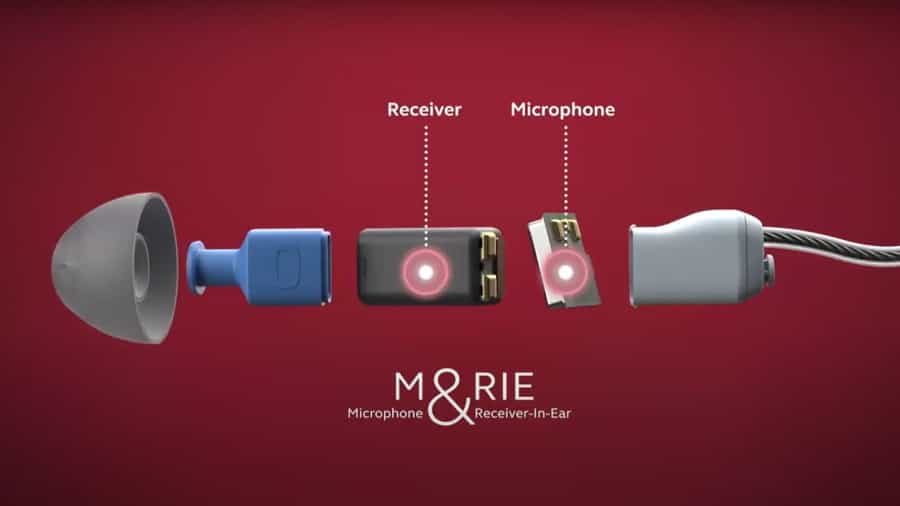Significance of ReSound’s M&RIE Technology in Enhancing Hearing Aid Performance
ReSound’s M&RIE technology is significant in enhancing the performance of hearing aids. By preserving the pinna effect, the M&RIE technology allows for the natural resonance signature provided by the pinna to be utilized, resulting in improved speech clarity and understanding. This leads to a more natural and comfortable listening experience for those with hearing loss.
Best breakthough in hearing aid technology in the last 5 years for those with mild to moderate hearing loss.

In addition, the placement of the microphone inside the ear canal reduces wind noise and leads to better localization and natural sound quality compared to behind-the-ear placement. These improvements result in a clearer and more stable sound in various listening environments, and a more satisfying overall hearing experience.
Clarification: M&RIE is an optional component on the Resound One and Resound Omnia devices
The M&RIE technology is a step forward in the development of hearing aids and represents a commitment to the organic hearing philosophy, which aims to enhance the natural hearing experience for those with hearing loss. ReSound’s M&RIE technology is a significant advancement in the field of audiology and has the potential to improve the quality of life for those with hearing loss.
ReSound’s M&RIE Technology

ReSound is the first hearing aid manufacturer to place a hearing aid microphone on the back of a receiver, known as the microphone and receiver in ear (M&RIE) technology. This technology is part of ReSound’s organic hearing philosophy, which aims to enhance the natural hearing experience for those with hearing loss.
Advantages of Placing Microphone inside the Ear Canal
Placing the microphone inside the ear canal allows for better utilization of the unique pinna effect. This is in contrast to traditional receiver-in-canal (RIC) hearing aid technology, which previously had microphones placed behind the ear in an effort to reduce feedback.
Correction Factors Used in Behind-the-Ear Microphone Placement
Placing the microphone behind the ear forces manufacturers to add correction factors to account for the lost pinna effect. These correction factors can negatively impact the natural sound quality and localization abilities of the hearing aid. It is better to have natures do it’s job instead of having technology try to replicate it.
Improved Localization and Sound Quality with M&RIE
With the M&RIE technology, the microphone is placed inside the ear canal, leading to better localization and natural sound quality compared to behind-the-ear placement. The pinna effect is preserved, resulting in a more natural and comfortable listening experience.
Reduction in Wind Noise
The placement of the microphone inside the ear canal also reduces wind noise by up to 19 decibels, compared to exposing the microphone behind the ear. This results in a clearer and more stable sound in windy environments.
Weaknesses of M&RIE
Only for Mild to Moderate hearing losses due to feedback issues.
Benefits of Preserving the Pinna Effect
By preserving the pinna effect, the M&RIE technology enhances the performance of the hearing aid. The unique resonance signature provided by the pinna is utilized, resulting in improved speech clarity and understanding, and a more natural and comfortable listening experience.
This next section is a deep dive. If you are interested these are the benefits of preserving the natural pinna.
Definition of Pinna
The pinna, also known as the auricle, is the visible part of the external ear that protrudes from the head. It is composed of cartilage covered by skin and is a crucial component of the human auditory system.
Importance of Pinna in Hearing
The pinna plays a vital role in the process of hearing by serving as the first point of contact for sound waves entering the ear. Its unique shape and structure help to shape and filter incoming sound, which enhances the localization and perception of sound sources. The pinna also helps to direct sound waves into the ear canal and towards the eardrum, where they are converted into vibrations that are transmitted to the inner ear.

Unique Shape of Pinna
The shape of the pinna is unique to each individual and is one of the factors that contribute to the variability of human hearing. The unique shape of the pinna allows it to impact the way sound is perceived by directing and filtering incoming sound waves in a way that is specific to each individual. This makes the pinna a crucial component in the overall hearing process and helps to ensure that each person’s auditory experience is personalized and optimized for their individual needs.
Sound Localization
The pinna plays an important role in identifying the source of a sound. It helps the brain to determine the location of a sound by providing information about the timing and intensity differences of the sound waves that reach each ear. The unique shape of the pinna causes these differences, which can help the brain to determine the location of a sound source in both the horizontal and vertical planes.
Brain’s Perception of Sound Shaped by Natural Pinna
The brain perceives sound that is shaped by the natural pinna since birth. This is because the unique shape of the pinna helps to filter and shape the sound waves that enter the ear, resulting in a unique resonance signature for each person. This resonance signature is what the brain uses to determine the location, direction, and quality of a sound source.

